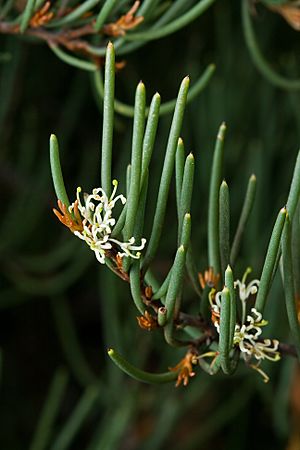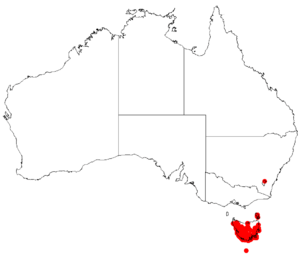Hakea epiglottis facts for kids
Quick facts for kids Hakea epiglottis |
|
|---|---|
 |
|
| Hakea epiglottis, Cape Raoul, Tasman Peninsula, Tasmania | |
| Scientific classification | |
| Genus: |
Hakea
|
| Species: |
epiglottis
|
 |
|
| Occurrence data from AVH | |
| Synonyms | |
|
|
Hakea epiglottis is a special kind of shrub, often called beaked hakea or needlebush hakea. It's found only in Tasmania, an island state of Australia. What's really interesting about this plant is that its populations often have separate male and female plants. Some very old specimens, found in places like Wakehurst Place in London, are believed to be 60-70 years old and can grow up to 3 meters (about 10 feet) tall and wide!
Contents
What Does Hakea Epiglottis Look Like?
Hakea epiglottis can grow up to 3 meters (about 10 feet) tall. Its leaves are like needles, about 1.5 to 11 centimeters (0.6 to 4.3 inches) long and 1 to 2 millimeters (0.04 to 0.08 inches) wide. When the leaves are young, they are covered in rust-colored hairs. This helps tell them apart from a similar plant called Hakea megadenia.
Flowers and Fruit
The flowers of Hakea epiglottis grow in clusters in the leaf corners during spring. Their colors can range from white to bright yellow.
- Male plants have flower clusters with 2 to 8 flowers.
- Female plants have fewer flowers, usually 1 to 3 in a cluster.
The small leaf-like structures under the flowers, called bracts, are about 3 to 4 millimeters (0.12 to 0.16 inches) long. The flower stems are about 3.5 to 5 millimeters (0.14 to 0.20 inches) long. They have flat, white, silky hairs. These hairs extend onto the sepals, which are like small leaves that protect the flower bud. The sepals are 2.5 to 4 millimeters (0.10 to 0.16 inches) long and pale yellow inside.
The pistil, which is the female part of the flower, is curved and about 5.5 to 6.5 millimeters (0.22 to 0.26 inches) long. The style has a small part called a pollen disc. In male flowers, this disc is hollow, but in female flowers, it has a small cone-shaped bump. The fruit of this plant are shaped like the letter 'S' and are about 1.4 to 2.6 centimeters (0.55 to 1.02 inches) long.
Male, Female, and Bisexual Plants
Most populations of Hakea epiglottis have separate male and female plants.
- Male plants produce flowers with pollen but do not grow fruit.
- Female plants produce fruit but their flowers do not have pollen.
However, some populations have been found where plants are bisexual. This means they have both fruit and flowers that produce pollen on the same plant.
How Hakea Epiglottis Got Its Name
The scientific name for this plant, Hakea epiglottis, was first officially written down by a scientist named Jacques Labillardière in 1805. He published it in his book Novae Hollandiae Plantarum Specimen.
The second part of the name, epiglottis, comes from two Ancient Greek words:
- Epi means "upon" or "on".
- Glottis means "mouth of the windpipe".
Scientists think this name might refer to how the fruit looks a bit like the upper part of our breathing system.
Different Types of Hakea Epiglottis
There are two main types, or subspecies, of Hakea epiglottis:
- Hakea epiglottis subsp. epiglottis : This type has white hairs on its flower stalks and at the base of the flowers. It is found in most parts of Tasmania, except for the very north-eastern coast.
- Hakea epiglottis subsp. milliganii : This type has yellowish-white hairs on its flower stalks, but rusty-colored hairs near the base of the flower. It is found in a smaller area, only along the west coast of Tasmania, between Zeehan and Macquarie Harbour.
Where Hakea Epiglottis Lives
Hakea epiglottis is a common plant in Tasmania. You can find it almost everywhere on the island, except for the north-east coast. It likes to grow in wet, peaty areas, often in a type of open shrubland called heath.

